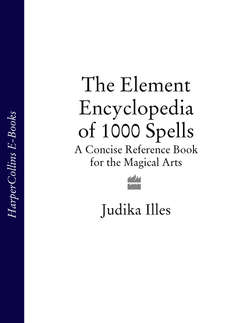Читать книгу The Element Encyclopedia of 1000 Spells: A Concise Reference Book for the Magical Arts - Judika Illes - Страница 84
Identification/Syncretism
ОглавлениеSyncretism is the system by which one spirit is identified or fused to varying degrees with another. Although the process is most commonly and consciously associated with modern African-Diaspora faiths, the tradition goes back millennia.
When the ancient Greeks began to travel their world, they encountered other people (Egyptians, Persians) with other pantheons. This frustrated them. Although they didn’t insist on one god, they did insist on their own gods. Who were these other spirits? In some cases, spirits from abroad (Dionysus, Hecate) were merged into their own pantheon. In other cases, the Greeks decided, other cultures simply used other names and told other stories about spirits who were the same as the Greek gods. Thus they created a system of identification: Hathor was a beautiful spirit of love, who liked perfume and music. She must be Aphrodite, also a beautiful spirit of love, who liked perfume and music. Although sometimes neat, obvious identifications can be made, sometimes this leads to confusion. The Persian spirit, Anahita, was a beautiful deity interested in human romantic and reproductive matters. Obviously she was identified as Aphrodite (identification means she was Aphrodite), but Anahita also had a martial aspect, driving a chariot, leading men to war. Therefore she must be Athena, too.
Identification therefore attempts to identify one spirit within another. Syncretism takes this a step further. One spirit wears the mask of another. When one pantheon is outlawed, the only way to continue devotion to now-banned spirits is to pretend that you’re worshipping others. This is precisely what happened to enslaved Africans in the Western hemisphere. Forbidden to practice their own faith, they accommodated it to another. Syncretism permits forbidden spirits to wear acceptable masks. Syncretism also means that acceptable saints are incorporated into magic spells in surprising ways because, in essence, they are fronting for that forbidden someone else. How else can one reconcile the conventional and devout “official ” Saint Anthony of Padua with the witch-doctor persona he displays so powerfully and benevolently in a multitude of magic spells?
Spirits, like magic in general, are fluid in nature. Shape-shifting isn’t hard for them, even without conscious syncretism. Hence India’s Durga is an aspect of Parvati. In a moment of terrible stress, Durga unleashed her alter ego, Kali. All three are aspects of one, but all three are distinct beings, too. Confused? Well, you should be, it is confusing.
The realm of the spirits is like a journey through a dream landscape. Syncretism only increases the confusion.
Because the syncretism of the African slaves was born of desperation, quick, frequently visual identifications were made. Slaves were forbidden to practice their own religions but were permitted Roman Catholic chromolithographs of saints. They scoured them, looking for coded references to the orisha and lwa. Sometimes these identifications really work: Ogun, spirit of iron, was syncretized with the archangel Michael because in his most famous image Michael wields a sword. Yet they genuinely have much in common: both are tireless workers and warriors on behalf of human safety. Michael even has his own associations with iron. Sometimes syncretism is surreal: Chango, that most virile spirit of fire and lightning, is syncretized to the virgin martyr Saint Barbara, because her chromolithograph depicts a lightning bolt.
The first generation to engage in syncretization is conscious of what they’re doing. After that, though, all bets are off. At what point, if any, do these spirits genuinely fuse? Perhaps Saint Peter, syncretized to road-opener Elegba because of his keys, really is Elegba or vice-versa. And if you’re invoking Saint Peter in a magic spell, are you really invoking the saint or Elegba, hiding within, even if, after three generations, the orisha is no longer remembered?
Santeria earned its name, “religion of the saints,” because of syncretism. Those who emphasize Roman Catholic ties prefer to emphasize the saints or perhaps a combination. Those who emphasize African roots prefer to emphasize the orisha or perhaps a combination. Others can no longer separate saint from orisha; true fusion has occurred for them. In Brazil, there have been calls to end syncretism as it is no longer necessary.
Were authorities truly unaware of the slaves’ subterfuge? It’s hard to say. This system of identifying and syncretizing spirits is present whenever one faith demands that another abandon and deny its spirits. Sometimes religious authorities presented syncretism to a population to make the new religion palatable. Hence, Goddess Aine becomes a Fairy Queen. She remains accessible to old devotees in that role, if not in her old one, which was perceived as dangerous to the new religious authority. Celtic spirit Brigid, the Druid’s daughter, becomes identified with Saint Brigid. They merge; where one stops and the other starts becomes very difficult to determine.
Sometimes, however, this process backfires. In the case of Maximon, also known as Brother Simon, missionaries’ attempts to assimilate the Guatemalan spirit Maam with Saint Simon backfired. Maximon, spirit of male primal energy, defied boundaries and took on a life of his own. The Church then attempted to syncretize him with Judas Iscariot or even with the devil. This only enhanced Maximon’s outlaw image, making his devotees love him even more. Although intended to merge, to syncretize, with an “official ” saint, Maximon instead has emerged as a powerful “unofficial ” saint.
Sometimes syncretism occurred so long ago that the original spirit hiding underneath is completely forgotten. The only way to recognize that syncretism may have occurred is the observation that the saint behaves in a strangely un-saint-like manner. This applies particularly to the Big Three of magical Catholic saints, Saint Anthony, Saint George, and John the Baptist. Although perhaps completely forgotten spirits lurk within, many believe that under their respective masks lie Hermes, Baal, and Adonis.
